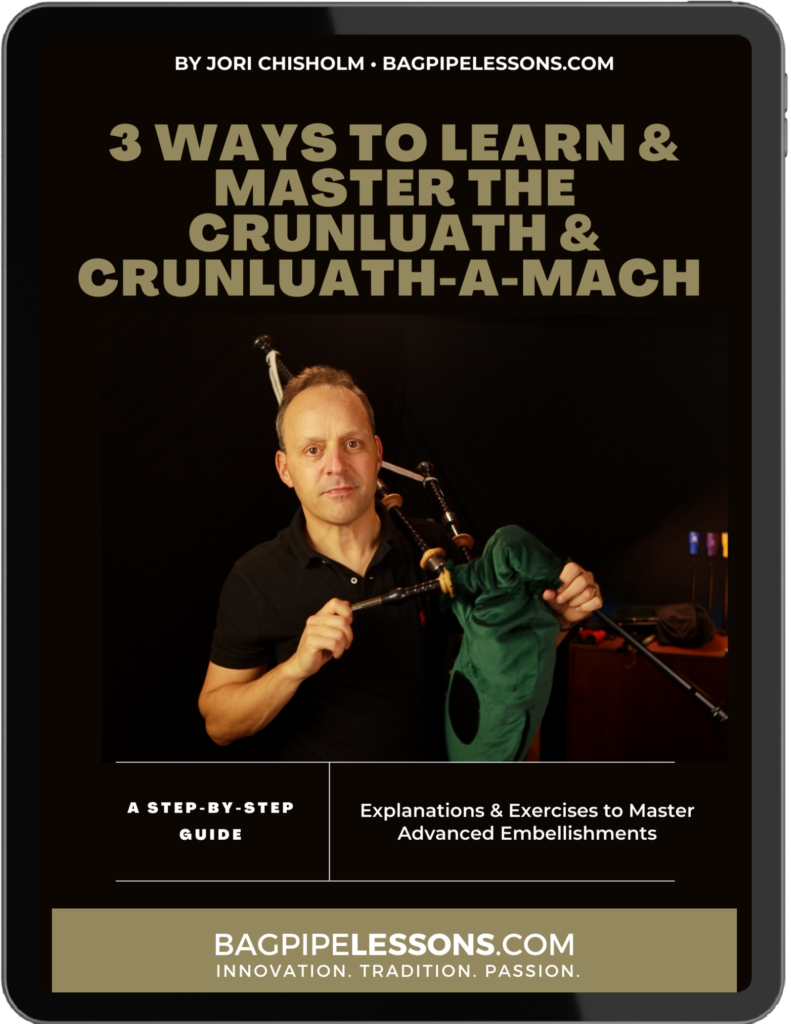
AS FEATURED IN

Three Ways to Learn and Master the Crunluath & Crunluath-a-Mach
by Jori Chisholm, Founder of BagpipeLessons.com
Last Updated: April 11, 2025
The crunluath and the crunluath-a-mach are some of the most challenging and important bagpipe embellishments. They showcase the piper’s skill, mastery and understanding. If you’ve tried to learn the crunluath, you already know how difficult it can be to perform it consistently! Let me guide you through a lesson where you’ll learn the right way to approach the crunluath and crunluath-a-mach.
Watch the video and scroll down to read the full video script.
Video Transcript:
In this video, we’ll take a detailed look at two of the most important and challenging fingering embellishments in all of bagpipe music: the crunluath and the crunluath-a-mach. I’ll demonstrate these movements for you on the pipes and on the practice chanter at different speeds, and break them down three different ways so you’ll know exactly what to play and what to listen for, so you can make fast progress with your practicing and play with greater confidence.
My name is Jori Chisholm. I started BagpipeLessons.com with the goal to provide high-quality innovative products and inspiration for anyone who wants to learn to play the pipes, regardless of your previous experience or where you live in the world. The video you’re about to watch was recorded for members of my BagpipeLessons.com Inner Circle.
Membership in my Inner Circle gives you complete access to the best of everything at BagpipeLessons.com, including weekly live and interactive online classes for pipers of all levels with me and world champion guest instructors, access to my exclusive lesson library with hundreds of hours of lessons on nearly every piping topic, and personalized support from me to help you make your piping dreams a reality.
To learn more about joining my Inner Circle and to watch and download some more of these great lessons for free, please visit BagpipeLessons.com/membership. And make sure to hit the subscribe button and click on the little bell button to be notified when I post new videos here on my BagpipeLessons.com YouTube channel.
The crunluath and crunluath-a-mach are used in the final climatic variations of many tunes where the tempo and technical virtuosity are at their peak. It’s considered one of the most important piping embellishments and also one of the most revered and feared. The ability to achieve a perfect technical execution of dozens of crunluath-a-machs at the end of a pibroch is considered a rite of passage for pipers. If you’ve tried to learn the crunluath, you know how hard it is to achieve that sort of mastery and consistency.
The crunluath and crunluath-a-mach are different embellishments which are played together. Let’s start with the crunluath. The simplest way to think about a crunluath is it’s two low Gs and two low A’s followed by an E, preceded by the theme note. So the theme note can be any note and the theme notes will change depending on the melody of the tune, but the crunluath is always the same: two low Gs, two low A’s followed by E. Between the two low Gs is a D grace note, between the low G and the low A is an E grace note, and between the two low A’s is an F grace note.
So you’d have some notes at the beginning for example low A, played up to speed. We want to hear the low G’s in the lowest but the grace notes are true grace notes, we want those to be really small. Here’s another way to approach it, let’s focus on the timing of the theme note and then the E after the embellishment first. It’s a sort of a 6/8 type rhythm and the theme note is twice as long as the E, so just the theme note and an E would be. Usually, the theme note has a G grace note on it.
Now let’s start adding in some notes of the crunluath itself. Let’s add in a low G. Now let’s add in a low A. Now let’s add an E grace note when we transition from low G to low A. Let’s take that low A and let’s split it in two. We add an F grace note in the middle of that of low A to split it into two low As. Now finally the last step is to add a D grace note in the middle of that low G which splits the low G into two. So all those steps. And there it, as we speed it up.
Another exercise for mastering the crunluath is to start at the end of the crunluath. For a lot of pipers, the trickiest part of the crunluath is getting the control of the F grace note. Typically, it’s the F grace though that needs some extra practice, so let’s start with just doing some F grace notes on low A. We want that grace note to be as small as we can make it, really small without tightening up the hand, so keep the hands relaxed. Remember the two pillars of good form: minimum necessary tension and minimum necessary height. So keeping the fingers in nice and close and keeping them loose, that’s going to help with your technique in general but specifically here with having clean small grace notes.
So again, now let’s add an E at the end of that. Now let’s add a low A before that, and then add a grace note between the two low ends, so low A, E grace notes, F grace note and then E.
For the next step, just change that first low A to low G. Now let’s add a low G at the beginning and we’ll put a D grace note between the two low G’s. Speed up the timing of those two low Gs to match the low A and put a low A at the very beginning so a low A and then our two low Gs are two low As all the way up to the E. So that’s the entire crunluath, the only thing we need to do now is put a G grace note on the theme note that’s the long low A before the movement and then put it into that 6/8 timing where the theme note is twice as long as the E.
Now there’s a couple special things that we need to mention about the crunluath and that is the crunluath from low G, the crunluath from D are slightly different. Let’s start with the crunluath from D. Now if you’ve played a taorluath from D you know that there’s a different grace note that we put in that taorluath from D. Instead of playing the D grace note we play a B grace note which is the ring finger and we do the same substitution of the B grace note in the crunluath from D when we’re playing our crunluath from D we go to low G and instead of playing the D grace note we play a B grace note and the best thing that you can do to set yourself up for success with that B grace note is to keep your hands as relaxed as possible. The tighter you get, the harder it will be for that B grace note to come out. That B grace note likes to move with another finger, so we can play C just fine when the ring and middle move together. We can play B just fine when the pinky and ring move together, but when the pinky and the middle finger are down and the ring finger is coming up on its own, it’s really important that your hands stay relaxed. Most people can move their ring finger all day long with no problem, but as soon as you tense up, it’s locked down. So, keep that finger loose.
The other special case with the crunluath is the crunluath from low G. Now, that’s a low G theme note, so you might think that if you’re on low G already, when you’re going to play your crunluath. The first low G of the crunluath would just disappear into the low G theme note because they’re the same note and then you would just play your D grace note and then your E grace note to low A. But there’s a little change there: the first low G of the crunluath disappears because it just gets sort of absorbed into the low G theme note. But the second low G we change to low A. So, instead of having in our regular crunluaths from all of our other notes, we have two low Gs, two low A’s in the crunluath from low G. There’s no low G’s at all in the crunluath. The first low G disappears, the second low G turns into low A. So I actually have three low As. So what that looks like is low G and then you do a D grace note to low A, and then your E grace note, F grace note, both on the way and then up. There is a minority of pipers who do play that first low G in the crunluath, and the overwhelming majority of pipers play the way I showed you, popping up to low A and having three low As.
The other thing I’ll mention, if you’re a pibroch player, you know that the high G is always played in pibroch with the middle finger down. That’s the pibroch high G. We never play the standard high G in a pibroch just as we never play the pibroch high G in our non-pibroch tunes.
Now, the crunluath-a-mach is an additional embellishment that’s added as the final variation for some pibroch. So, in some pibroch you’ll see, there’s a variation after the crunluath and the crunluath doubling which is the crunluath-a-mach variation. In some tunes it’s required, in some tunes it’s never played, and in some tunes it’s optional. So you’re just going to have to talk to your instructor or find recordings or talk to an expert who knows the tune that you’re working on to find out if you need to play the crunluath-a-mach or not.
The crunluath-a-mach variation is identical to the preceding variation and on specific notes, instead of playing the crunluath you play the crunluath-a-mach B, C, and D. Those are the only three notes that have a crunluath-a-mach embellishment. If your crunluath doubling has all sorts of different notes up and down the scale, when you play your mach variation, you play the entire variation but on the Bs and the Cs and the Ds you replace the crunluath. So, let’s see what that embellishment looks like.
The B crunluath-a-mach is played with a G grace note to B, grip to B, and then an open E and an open edre means you play the edre grace notes E, F and then you finish on E. What makes it an open edre is that the ring finger that’s up for the preceding note before the edre was B. I keep my bottom hand on B. Normally the edre has two low As in it. A normal edre would be this: the E, F grace note followed by E with low As. But for the open edre, you were already on B just before, and you stay on B on the bottom hand.
So, the difference is a regular edre, the open edre. Notice there when I do get to the E at the end, even with the open edre, I still have then I have to bring that finger down so it’s only open for the duration of the embellishment. So what B crunluath-a-mach sounds like: G grace note to B, grip to B, open E dre to E, and then full speed. So the key there is the G grace note to B and immediately to the low G of the grip. It’s a mistake to play to open up that B before the grip.
You really want to hit the grip, and then a little bit of a pause after the grip before your edre. I think the most pipers when they’re learning the a-mach and they’re working on that grip portion, they make the mistake of making the B before the grip too long and making the low Gs in the grip too small. So it sounds like a big B, a very light grip like this. We want the opposite. We want a very quick B at the beginning and lots of solid low G.
The C crunluath is exactly the same as what we just did on B except for all the B’s are replaced with C’s. So that’s G grace note to C, grip to C, and then open E dre on C followed by E.
Sometimes you’ll have just Bs or just Cs or some of each. The third a-mach note is D and it’s different. You might think, “Oh we just play D grip to D and then the edre.” But we don’t play a lot of grips from D or grips to D. What’s an embellishment that we have that we play a lot of in our tunes that ends on D? The D throw. So instead of a grip we play a D throw and here’s a little change. It’s something unexpected but fits a pattern that we’ve seen before. Remember in our D crunluath instead of playing a D grace note we played a B grace note? And with the D taorluath instead of playing a D grace note we play a B grace note? Well here in the D a-mach we play a D throw but instead of D before the D throw, we play B.
So the D crunluath-a-mach is G grace note to B followed by a light D throw and then the open edre to E. You get a very quick B, a nice solid but light and fast D, a tiny pause and then our open edre.
So one really cool thing about this a-mach variation is that you have a mix of these a-mach embellishments and the regular crunluath embellishments because we played those on all of our other notes: low G, low A, and then E and up. So you get a mix, it creates a unique and interesting sound when played in combination with the regular crunluath embellishments.
The reason that mix sounds so interesting and exciting when you get to it is that the timing of the a-mach is reversed from the regular crunluath. In fact, the timing of the a-mach is reversed from all of the other taorluaths, crunluaths, leumluaths, and almost all the other embellishments that we have in pibroch. It’s a long theme note followed by a quick embellishment and then a short note after it. So the regular crunluath is that 6/8 pattern where you have a long theme note, your crunluath, and then an E, and the E is about half the length of the theme note.
So it’s long crunluath, long crunluath, or in a taorluath, it’s a long theme note and then a taorluath and a very cut low A. The leumluaths are the same way and some of our earlier variations are dot cut.
The a-mach timing is reversed in that the first thing that you hold in the a-mach is the note after the a-mach. So in a crunluath you hold the note before the crunluath, then pull the embellishment, and then a shorter E. And in an a-mach movement, you just hit that a-mach movement and then you hold the E for the rest of the duration. So what you get is a kind of alternating pattern.
So let me just play some crunluaths first and then you’ll hear when the a-mach comes in. You’ll hear it’s very sort of surprising or a little bit startling if you’re not ready for it. Then the interplay between the a-mach and the regular crunluath is really cool.
So that’s the crunluath and the crunluath-a-mach, one of the hardest and most exciting but most necessary embellishments in all of piping. I hope you’ve enjoyed the lesson. Stick with it, take things step by step, and you can do it.
Thanks for watching, don’t forget to hit the subscribe button and the little bell button to be notified when I post new stuff here on the BagpipeLessons.com YouTube channel, and be sure to visit BagpipeLessons.com/Learn to watch and download some more videos and lessons like this one for free.
Thank you.





